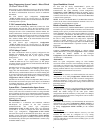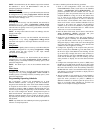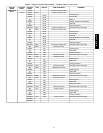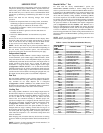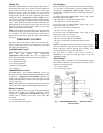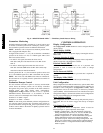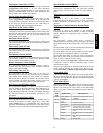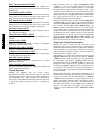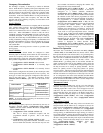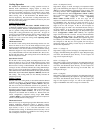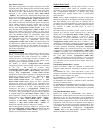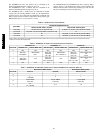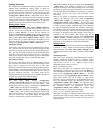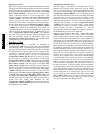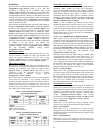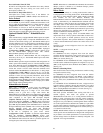
17
Occupancy Determination
The building’s occupancy is affected by a number of different
factors. When the unit is operating with a space temperature sensor
(T−55, T−56, T−58 or T−59), occupancy affects the unit set points
and the operation of the economizer. If the unit is operating under
thermostat control, occupancy only affects the operation of the
economizer. If the unit’s Humidi−MiZer is being controlled by a
relative humidity sensor, then occupancy will affect the RH
setpoints. The factors affecting occupancy are listed below from
highest to lowest priority.
Level 1 Priority
Level 1 classification is a force/write to occupancy and can occur three
ways. Listed in order of priority: force on OCCUPIED, a write to
NVI_OCC, and a Linkage write. The CCN point OCCUPIED is
forced via an external device such as a ComfortID controller or a
service tool. When OCCUPIED is forced to YES, the unit is
considered occupied, when OCCUPIED is forced to NO, the unit is
considered unoccupied. If the 3rd party protocol LON is writing to
NVI_OCC, the control maps it to OCCUPIED as an input. If the unit
is being controlled by Linkage, the occupancy is communicated and
mapped to OCCUPIED as an input. LON and Linkage do not force
the point, only write to it, therefore a force applied to OCCUPIED
will override them.
If OCCUPIED is not being forced or written to, proceed to the
level 2 priority.
Level 2 Priority
Remote Occupancy Switch should be configured to either
Normally Open or Normally Closed when the user would like to
control the occupancy with an external switch. This switch is
field−supplied (24v, single pole, single throw [SPST]). There are
three possible configurations for the remote occupancy switch:
1. (Configuration→UNIT→RM.SW = 0) No Switch
2. (Configuration→UNIT→RM.SW = 1) Normally Open
Switch
3. (Configuration→UNIT→RM.SW = 2) Normally Closed
Switch
If the switch is configured to No Switch (0), the switch input value
will be ignored and software will proceed to level 3 priority. For
each type of switch, the appropriate configuration and states are
listed in the table below. The Remote Occupancy Switch
(INPUTS→GEN.I→RM.OC) point will show the status of the
switch.
TYPE OF SWITCH
SWITCH
CONFIGURATION
STATE OF SWITCH
AND STATE OF
OCCUPANCY
Occupied when Closed
or Unoccupied when
Open
Normal Open (1)
Open and Unoccupied
Closed and Occupied
Occupied when Open or
Unoccupied when
Closed
Normal Closed (2)
Open and Occupied
Closed and Unoccupied
NOTE: To perform remote occupancy, an Economizer Control
Board must be installed in the unit.
Level 3 Priority
The following occupancy options are determined by the state of
Occupancy Schedule Number (Configuration→CCN→SCH.O
→SCH.N) and the Global Schedule Broadcast (Configuration
→CCN→ BROD→B.GS).
1. (Configuration→CCN→SCH.O→SCH.N = 0)
The unit is always considered occupied and the
programmed schedule is ignored. This is the factory
default.
2. (Configuration→CCN→SCH.O→SCH.N = 1−64)
Follow the local programmed schedule. Schedules 1 to 64
are local within the controller. The unit can only store one
local schedule and therefore changing this number only
changes the title of the schedule table.
3. (Configuration→CCN→SCH.O→SCH.N = 65−99)
Follow the global programmed schedule. If the unit is
configured as a Global Schedule Broadcaster
(Configuration→CCN→BROD→B.GS = YES), the unit
will follow the unit’s programmed schedule and broadcast
the schedule so that other devices programmed to follow
this schedule number can receive the schedule. If the unit is
not programmed as a Global Schedule Broadcaster
(Configuration→CCN→BROD→B.GS = NO), the unit
will receive broadcasted schedules from a unit programmed
to broadcast this schedule number. While using the
programmed schedule, occupancy can be temporarily
switched from unoccupied to occupied by pressing the
override button for approximately 3 seconds on the T−55,
T−56, T−58 or T−59 space temperature sensor. Override
will only occur if SPT Override Enabled (Configuration
→CCN→SCH.O→OV.SP) is set to YES. The length of the
override period when pressing the override button is
determined by the Override Time Limit (Configuration
→CCN→SCH.O→OV.TL). The hours remaining in
override is displayed as Timed Override Hours
(Configuration→CCN→SCH.O→OV.EX). This point can
also be changed from the local display or network to set or
change the override period length.
Indoor Fan Operation
The indoor fan is controlled by the Indoor Fan Relay (Outputs
→FANS→IDF) on the MBB (main base board) control, which
then operates the indoor fan contactor (IFC). For gas heating units,
the IGC control fan output is also monitored by the MBB control.
This can result in additional modification of fan delays or other
operation due to safety functions of the IGC control. The
Humidi−MiZer gas heating units do not monitor the IGC fan
output; instead an indoor fan on relay (IFOR) is used to allow the
IGC to turn the fan on. If configured for IAQ fan operation, the
fan may be turned on to satisfy air quality demands. See the
Indoor Air Quality section if using IAQ (indoor air quality)
accessory sensors. The fan can only be turned on under thermostat
or space sensor control if the System Mode (SYS) status is enabled.
The fan will remain on if compressors or heat relays are ever stuck
on. If configured for fan status switch (FN.SW) and Shut Down
on IDF Failure (Configuration→UNIT→IDF.F = Yes) is enabled,
the fan and unit will be shutdown on alarm. See the Adaptive Fan
section for information on its operation.
Thermostat Control
In thermostat mode, the IDF relay will be on in the following
situations: fan request G in ON, cooling request Y1 or Y2 is ON,
or heating request W1 or W2 is ON. If G is dropped or never on
with an Y1, Y2, W1, or W2 call, the IDF relay will turn off after a
configurable time delay with respect to the HVAC mode that is
ending. The Fan−off Delay delays are as follows: Mech Cool
(Configuration→COOL→FOD.C), Elect Heat (Configuration
→HEAT→FOD.E), and Gas Heat (Configuration→HEAT
→FOD.G).
Space Sensor Control
In Space Sensor mode, the IDF relay will be on if the unit is in
Occupied mode and the indoor fan is configured to always run
while occupied (Configuration→UNIT→OC.FN = YES). If the
indoor fan is configured for intermittent fan (Configuration
→UNIT→OC.FN = No), the fan will only be on when there are
cooling, heating, or dehumidification stages running; or if there is
an air quality demand. During the unoccupied period, the fan will
operate intermittent. With intermittent fan, the IDF relay will turn
off after a configurable time delay with respect to the HVAC mode
that is ending. The Fan−off Delay delays are as follows: Mech
Cool (Configuration→COOL →FOD.C), Elect Heat
(Configuration→HEAT→FOD.E), and Gas Heat
(Configuration→HEAT→FOD.G).
48/50PG and PM



